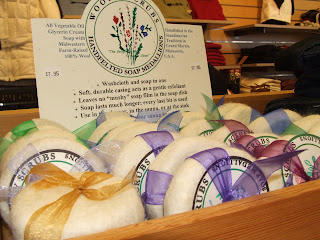When you look at a fluffy, wooly sheep what do you think of (besides how cute and fuzzy it is)? Mutton? Lamb chops? Sweaters and socks?
All good stuff . . . but someone way way WAY back when looked at a sheep and thought, “hmmm, I sure wish I had a warm coat like that”. He probably skinned the poor, yummy creature, roasted it on a spit and wrapped himself in the cozy fleece.
There’s no doubt about it, sheep wool is dadburn warm! The kinky fibers are loaded with air pockets that create outstanding insulation. The fibers are also very absorbent. Wool very slowly absorbs moisture from the air allowing body temperature to warm the moistened material. Wool is slow to feel damp, and it dries just as slowly; which means it does not chill the wearer as the moisture evaporates.
One of the earliest fabrics made from wool is felt. Felting creates a strong, sturdy material and requires no skill.
All you need is heat, moisture and friction. Heat and moisture cause the outer scales along the fiber to open like barbs on a fishhook. An alkaline like soap allows the fibers to slide easily over one another thereby causing them to become more easily entangled. The fibers permanently bind to one another and felting is not reversible.
That’s why you don’t put a natural wool garment in the washing machine, unless you want a new outfit for your Barbie-doll.
The result is a thick, matted fabric that can be cut without fraying.
| My husband pointed out some bars of soap that had felting over them at a local store. Soap and a washcloth all in one! Hmmm . . . I thought . . . what a clever idea. I can do that! And so I did! |
Felted Soap
- A Bar Of Soap
- Carded Wool
- A Towel
- Dish Of Hot Water
Wrap wool around the bar of soap lengthwise and longwise so that all the surfaces are covered.
Begin wetting the bar of soap by dribbling the hot water on it. Just a little at a time, trickle water on the wool and pat it to get it wet all the way through. Don’t dunk it or the wool will slide off.
When the wool is wet through, squeeze it and drip water on it periodically. You will notice that the wool will start to make a wrinkly skin around the bar of soap.
Keep squeezing it, shifting it around in your hands as you do so. It will start to lather up. Keep adding water to keep it lathered. The wool will start felting and lose the wrinkles.
Your can rub your hands over the surface of the bar now, and the wool won't slip off. It should be very sudsy.
Continue to rub it, turn it and squeeze it in your hands; making sure to rub all the sides.
Dunk it in the dish of water to see if it has felted down to make a fairly snug casing around the bar of soap. If it still seems a little fluffy, rub some more.
When it is snug around the bar of soap, run it under cold water, to tighten up the wool, and to rinse off more of the suds.
Allow to dry and you have a lovely bar of felted soap . . . soap with it’s own cloth wrapped around it . . . how cool is that?













I so love this post, Cher! I've been needlefelting soap for years and find the combination of good soap and good wool is not only fun - it's definitely good for the hands and the heart!
ReplyDelete